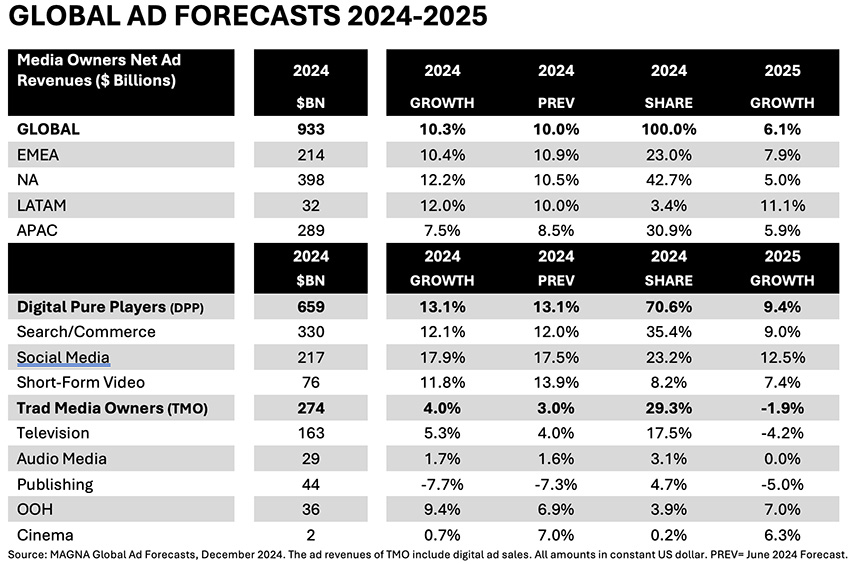Published on Digiday
This week’s Future of TV Briefing looks at the role that two old-school advertising tactics can play in the still-developing CTV ad market.
-
- See TV
- Streaming’s TV watch time share peaks
- TikTok loses bid to avoid ban, Comcast and WBD bundle up, Paramount set to slim down, and more
See TV
Maybe the connected TV ad market needs to get more traditional to advance.
I’ve had two conversations in the past week that have led to this line of thinking. The first was with Tinuiti’s Harry Browne about CTV ad measurement during last week’s Digiday Programmatic Marketing Summit. And the second was with Magna’s Kara Manatt about a study the agency did with ad tech firm Nexxen regarding CTV ad creative. Each conversation made a case for CTV — the presumptive future of TV — being in need of old-world “technologies” (if you can call them that): media mix models and focus groups.
In both cases, the underlying motivation seems to be an urge among advertisers to better gauge and guarantee the incremental benefits of their ad buys: To what extent did a campaign actually improve a brand’s chances of converting a consumer into a customer? And to what extent can the brand improve a campaign’s chances of delivering that incremental performance?
“There is just an under-leveraging of incrementality testing across the board, across channels. This is not just a CTV issue; this is across everything. But for CTV, it’s certainly relevant. Incrementality testing is critical. You need to understand what each of your investments is doing for you, above and beyond the other investments that you’re making,” Browne, Tinuiti’s vp of TV, audio and display innovation, said during an on-stage session at DPMS.
CTV seems to be fertile ground for incremental improvements given that it simultaneously offers an upper-funnel forum for reaching broad audiences as well as provides some means for more intelligently reaching those audiences and reaching conclusions on how effectively they were reached. Plus, advertisers continue to pour more money into the medium.
However, despite being an internet-connected device and having identifiers in the form of email addresses, IP addresses and device IDs, measurement for CTV campaigns is still challenged.
“Because of the fact that CTV is not a click-based medium — the ad is served on your television and that conversion happens later on a different device, maybe in a different place — that makes it so much harder from a measurement perspective,” said Browne.
Enter media mix models. They provide a means for comparing CTV campaigns’ performance in relation to other media channels, from traditional TV to search, social, display, etc., so that advertisers can see how each channel contributes on objectives ranging from brand awareness to purchase intent.
“You need some sort of framework to say, ‘CTV gave this above and beyond what my investments on search and social and commerce and display and everything else gave me,” said Browne.
While Browne discussed the post-campaign assessment of an ad’s performance, there’s also an argument that advertisers may be under-leveraging tests on the pre-campaign end to see how relevant an ad may be to its intended audience, which would affect any incremental improvements in brand recall, purchase intent, etc. “We have to use data-fueled creative … because what is interesting to one person and relevant to one person is not necessarily relevant to another person,” said Manatt, Magna’s evp of intelligence solutions.
To that end, Magna and Nexxen conducted a study that used Nexxen’s audience panel to track viewers’ assessments of ads and then applied that data to optimize the creative, such as observing if people struggled to recall the brand associated with an ad and editing the ad to highlight the brand toward the beginning. Another example would be gauging people’s high likelihood to purchase a product after seeing an ad and updating the ad to include a QR code to capitalize on propensity to purchase.
While the study of 943 adults found that optimized ads only delivered a 16% lift in respondents feeling that an ad was relevant, Manatt pointed to increased lifts in search intent and purchase intent as stronger signals. Per the study, optimized ads delivered a 76% lift in search intent versus a 47% lift for non-optimized ads and a 65% lift in purchase intent versus a 41% lift for non-optimized.
“When you get that higher relevance, we see how much more impact that we actually get on search intent, purchase intent, those transactional metrics that we care about most,” she said.
What we’ve heard
“In the U.S., we predict streaming revenue will overtake linear TV revenue in 2029.”
Streaming’s TV watch time share peaks
November was the latest high-water mark for the amount of time people spend streaming shows and movies each month, according to Nielsen’s latest viewership report The Gauge, which only looked at watch time through Nov. 24 (a.k.a. the Sunday before Thanksgiving).
In addition to streaming notching its largest TV watch time share to date, TV watch time overall reached its highest point since February when the Super Bowl helped to turn more people’s attentions to their TV screens. Major League Baseball’s World Series and the U.S. presidential election’s news bump helped to push up viewership for broadcast TV and cable TV, respectively.
Despite a record month for streaming’s watch time share, the shares for individual streamers did not fluctuate all that much. YouTube maintained its lead over Netflix for the largest share. Hulu registered the largest month-over-month increase at 0.3 percentage points, while sibling streamer Disney+ ceded the most share, losing 0.6 percentage points. And Paramount’s Pluto TV remained under the 1% threshold.
Numbers to know
1.8 billion: Total number of streaming subscriptions worldwide, as of this year.
>300,000: Number of podcasts on Spotify’s platform that are video podcasts.
20: Maximum length, in seconds, of videos that ChatGPT Plus and Pro users can create using OpenAI’s text-to-video generative AI tool Sora.



